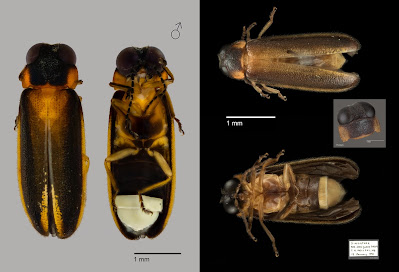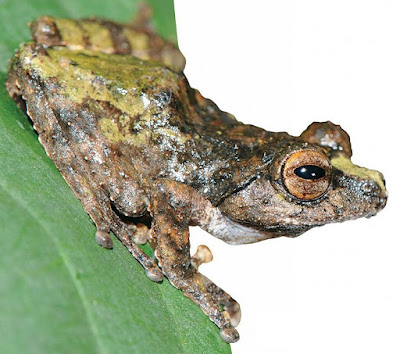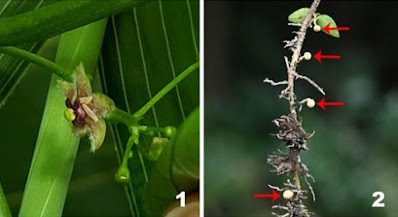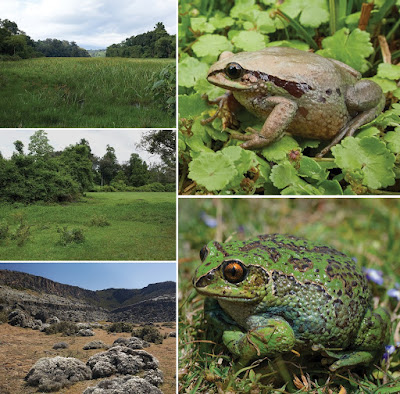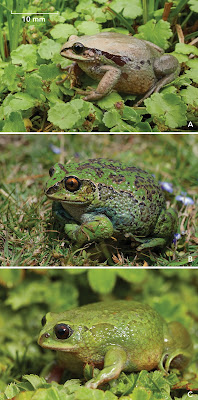[Most Recent Entries] [Calendar View]
Friday, March 12th, 2021
| Time | Event | ||
| 12:03a | [Entomology • 2021] Luciola singapura • Molecular Systematics of the Firefly Genus Luciola (Coleoptera: Lampyridae: Luciolinae) with the Description of a New Species from Singapore
Abstract The firefly genus Luciola sensu McDermott contains 282 species that are distributed across major parts of Asia, Europe, Africa, Australia, and the Pacific islands. Due to phenotypic similarities, species identification using external morphological characters can be unreliable for this group. Consequently, decades of piecemeal taxonomic treatments have resulted in numerous erroneous and contentious classifications. Furthermore, our understanding of the group’s evolutionary history is limited due to the lack of a robust phylogenetic framework that has also impeded efforts to stabilize its taxonomy. Here, we constructed molecular phylogenies of Luciola and its allies based on combined mitogenomes and Cytochrome c oxidase subunit 1 (COX1) sequences including a newly sequenced mitogenome of an unidentified taxon from Singapore. Our results showed that this taxon represents a distinct and hitherto undescribed evolutionary lineage that forms a clade with L. filiformis from Japan and L. curtithorax from China. Additionally, the Singaporean lineage can be differentiated from other congeners through several external and internal diagnostic morphological characters, and is thus described herein as a new species. Our phylogeny also strongly supported the paraphyly of Luciola with regard to L. cruciata and L. owadai, which were inferred to be more closely related to the genus Aquatica as opposed to other members of Luciola sensu stricto. The genus Hotaria was inferred as a derived clade within Luciola (sister to L. italica), supporting its status as a subgenus of Luciola instead of a distinct genus. This is the first time since 1909 that a new species of luminous firefly has been discovered in Singapore, highlighting the need for continued biodiversity research, even in small, well-studied and highly developed countries, such as Singapore. Keywords: Hotaria; Luciola cruciata; Luciola owadai; Nee Soon Swamp Forest; taxonomy; phylogenetics; conservation Luciola singapura Jusoh and Ballantyne sp. nov. English name: Singapore firefly Malay name: Kunang‐kunang Singapura Diagnosis: A small species (less than 5 mm long) with distinctive dorsal coloration of black head, orange to yellowish brown with dark markings on pronotum, and orange to yellowish brown elytra which have diffuse darker brown to black markings towards the apex, with paler basal markings restricted to basal area near suture and an accumulation of whitish fat body along apex of suture and round elytral apex. Metasternum with median dark marking. Etymology: The specific epithet, singapura, is the Malay name for the country Singapore, which is the type locality of the new species. Distribution: Known only from the type locality of NSSF, Central Catchment Nature Reserve in Singapore but may also occur in other parts of the island where habitat is suitable. Conclusions: The discovery of a new species of firefly from the last remaining freshwater swamp forest in Singapore—one of the most developed and urbanized countries in the world— highlights the importance of continued biodiversity research in the region. This study also underscores the utility of molecular approaches to resolve taxonomic problems and better understand the evolutionary history of fireflies. Wan F. A. Jusoh, Lesley Ballantyne, Su Hooi Chan, Tuan Wah Wong, Darren Yeo, B. Nada and Kin Onn Chan. 2021. Molecular Systematics of the Firefly Genus Luciola (Coleoptera: Lampyridae: Luciolinae) with the Description of a New Species from Singapore. Animals. 11(3), 687. DOI: 10.3390/ani11030687 Researchers from the Lee Kong Chian Natural History Museum, National University of Singapore, have discovered a new species of firefly from the last remaining freshwater swamp forest in Singapore. This is the first time since 1909 that a new species of luminous firefly has been discovered in Singapore—highlighting the need for continued biodiversity research, even in small, well-studied, and highly developed countries such as Singapore. Simple Summary: Fireflies have a scattered distribution in Singapore but are not as uncommon as many would generally assume. A nationwide survey of fireflies in 2009 across Singapore documented 11 species, including “Luciola sp. 2”, which is particularly noteworthy because the specimens were collected from a freshwater swamp forest in the central catchment area of Singapore and did not fit the descriptions of any known Luciola species. Ten years later, we revisited the same locality to collect new specimens and genetic material of Luciola sp. 2. Subsequently, the mitochondrial genome of that population was sequenced and specimens were subjected to rigorous morphological examinations. We then collated published mitogenomes and shorter mitochondrial markers from closely related taxa to infer a phylogeny for the subfamily Luciolinae. Our results reveal that Luciola sp. 2 is both genetically and morphologically distinct from other congeners and is thus described herein as a new species Luciola singapura sp. nov. This marks the first time since 1909 that a new species of luminous firefly has been discovered in Singapore, highlighting the need for continued biodiversity research, even in small, well-studied and highly developed countries such as Singapore that can still harbor undescribed biodiversity. | ||
| 12:06a | [Herpetology • 2021] An Integrative Approach to Infer Systematic Relationships and Define Species Groups in the Shrub Frog Genus Raorchestes (Anura, Rhacophoridae), with Description of Five New Species from the Western Ghats, India
Abstract The genus Raorchestes is a large radiation of Old World tree frogs for which the Western Ghats in Peninsular India is the major center for origin and diversification. Extensive studies on this group during the past two decades have resolved long-standing taxonomic confusions and uncovered several new species, resulting in a four-fold increase in the number of known Raorchestes frogs from this region. Our ongoing research has revealed another five new species in the genus, formally described as Raorchestes drutaahu sp. nov., Raorchestes kakkayamensis sp. nov., Raorchestes keirasabinae sp. nov., Raorchestes sanjappai sp. nov., and Raorchestes vellikkannan sp. nov., all from the State of Kerala in southern Western Ghats. Based on new collections, we also provide insights on the taxonomic identity of three previously known taxa. Furthermore, since attempts for an up-to-date comprehensive study of this taxonomically challenging genus using multiple integrative taxonomic approaches have been lacking, here we review the systematic affinities of all known Raorchestes species and define 16 species groups based on evidence from multi-gene (2,327 bp) phylogenetic analyses, several morphological characters (including eye colouration and pattern), and acoustic parameters (temporal and spectral properties, as well as calling height). The results of our study present novel insights to facilitate a better working taxonomy for this rather speciose and morphologically conserved radiation of shrub frogs. This will further enable proper field identification, provide momentum for multi-disciplinary studies, as well as assist conservation of one of the most colourful and acoustically diverse frog groups of the Western Ghats biodiversity hotspot. Raorchestes drutaahu sp. nov. Fast-calling Shrub Frog Etymology. The species name is derived from Sanskrit ‘druta’ (meaning fast) and ‘ahu’ (meaning call), referring to the fast-pulsatile calls of the new species. The species epithet drutaahu is treated as an invariable noun in apposition to the generic name. Distribution and natural history. Raorchestes drutaahu sp. nov. is endemic to the Western Ghats and currently known only from elevations ranging between 1,000 to 1,450 m asl at two localities: Kadalar in Idukki district (south of Palghat gap) and Siruvani in Palakkad district (north of Palghat gap). The species has been observed in forest areas, either on grassland-shola fringes or fragmented forest patches near plantations. Individuals were located on leaves of short shrubs at heights of 0.5–1.5 m. Raorchestes kakkayamensis sp. nov. Kakkayam Shrub Frog Etymology. The species is named after the place Kakkayam, where the type series was collected. Distribution and natural history. Raorchestes kakkayamensis sp. nov. is endemic to the Western Ghats and currently known only from its type locality (Kakkayam) in Kozhikode district, north of Palghat gap in Kerala State. The species was observed inside a primary forest patch and adjoining secondary forest areas at an elevation of 750 m asl. Individuals were located on the ground leaf litter or found perching on vegetation 1–3 m high. Raorchestes keirasabinae sp. nov. Keira’s Shrub Frog Etymology. The species is named after a young nature lover Keira Sabin, in appreciation of the long-time support and commitment of the Andrew Sabin Family Foundation towards amphibian research and conservation around the world. The species epithet keirasabinae is treated as a noun in the genitive case. Distribution and natural history. Raorchestes keirasabinae sp. nov. is endemic to the Western Ghats and currently known from elevations of 100–1,000 m asl south of Palghat gap. It has been observed at Agasthyamalai Biosphere Reserve (Chathankod-Makki, Ponmudi, Peppara Wildlife Sanctuary, and Shendurney Wildlife Sanctuary) in Thiruvananthapuram and Kollam districts, and Periyar Tiger Reserve in Idukki district of Kerala State. Since the species inhabits the highest canopy layers and cannot be located easily, it could have a wider geographical range in the Western Ghats regions south of Palghat gap, both in Kerala and the adjoining State of Tamil Nadu. The vocalisations of this species have not been recorded and analysed. Raorchestes sanjappai sp. nov. Sanjappa’s Shrub Frog Etymology. The species is named after Dr. M. Sanjappa, a renowned Indian Botanist and former Director of the Botanical Survey of India. The species name is in appreciation of his taxonomic contributions as well as generous support to SDB during the initial phases of his research career. The species epithet sanjappai is treated as a noun in the genitive case. Distribution and natural history. Raorchestes sanjappai sp. nov. is endemic to the Western Ghats and currently known only from an altitude of about 750 m asl at its type locality (Periya) that lies north of Palghat gap in the Wayanad district of Kerala State. The species was observed inside secondary forests and individuals were located on vegetation up to 3 m high during the breeding season. Raorchestes vellikkannan sp. nov. Silver-eyed Shrub Frog Etymology. The species name is derived from Malayalam (the language of Kerala State where the type series were collected) ‘velli’ (meaning silver) and ‘kannu’ (meaning eye) referring to the silver colour of the iris in this species. The species epithet vellikkannan is treated as an invariable noun in apposition to the generic name. Distribution and natural history. Raorchestes vellikkannan sp. nov. is endemic to the Western Ghats and currently known only from its type locality (Singappara, Siruvani) and surrounding regions of the Silent Valley National Park in Palakkad district of Kerala State, north of Palghat gap. This species was observed inside primary forests and individuals were found on vegetation up to 4 m high during the breeding season. The vocalisations of this species have not been recorded and analysed. Sonali Garg, Robin Suyesh, Sandeep Das, Mark A. Bee and S. D. Biju. 2021. An Integrative Approach to Infer Systematic Relationships and Define Species Groups in the Shrub Frog Genus Raorchestes, with Description of Five New Species from the Western Ghats, India. PeerJ. 9:e10791. DOI: 10.7717/peerj.10791 | ||
| 2:07a | [PaleoIchthyology • 2021] Austelliscus ferox • The Oldest Devonian Circumpolar Ray-finned Fish?
Abstract Actinopterygians (ray-finned fishes) are the most diverse group of living fishes, but have a sparse Devonian fossil record restricted to low palaeolatitudes. Here we report a new actinopterygian from the Paraná Basin of Brazil, which occupied a circumpolar position in the Palaeozoic. Available geological evidence supports a Middle Devonian or older age for this taxon, which shares features of the mandibular symphysis with the latest Devonian Tegeolepis. A phylogenetic analysis resolves these two as sister taxa. This new record expands the palaeogeographic distribution of Devonian ray-fins and suggests that gaps in their fossil record might be filled by exploring poorly sampled high-latitude localities within the Malvinokaffric Realm. Keywords: Osteichthyes, Actinopterygii, Malvinokaffric, palaeopolar, Devonian, Brazil Subjects Systematic palaeontology Osteichthyes Huxley, 1880 Actinopterygii Cope, 1887 Austelliscus ferox gen. et sp. nov. Etymology: The generic name references the high palaeolatitude locality (austelli, from the Latin meaning ‘the southern portion'), combined with the Latin suffix for ‘fish' (iscus). Species epithet alludes to the large teeth of the specimen (ferox, from the Latin meaning ‘ferocious'). Generic diagnosis: Actinopterygian with robust, conical, anteriorly oriented teeth on the dentary, except for the symphysis where teeth point posteriorly; symphysis reflexed posteriorly; jaw ramus constricted posterior to the symphysis. Differs from Tegeolepis in having: large oval replacement sockets in the lingual tooth row (rather than circular); lingual and labial tooth series converge posteriorly (rather than remaining well separated); more substantial post-symphyseal constriction of the dentary; the external surface of dentary ornamented with rounded tubercles anteroventrally and vermiform ornamentation posteriorly (rather than having only sparse tubercles and ridges). Holotype: MCT890-P, the mould of an incomplete left dentary in part and counterpart. Rodrigo Tinoco Figueroa, Luiz Carlos Weinschütz and Matt Friedman. 2021. The Oldest Devonian Circumpolar Ray-finned Fish? Biology Letters. DOI: 10.1098/rsbl.2020.0766 | ||
| 9:26a | [Entomology • 2021] Three New Species of Ametrodiplosis (Diptera: Cecidomyiidae) from Japan, with A Key to the Japanese Species and A Molecular Phylogenetic Analysis
Abstract Ametrodiplosis Rübsaamen (Diptera: Cecidomyiidae: Clinodiplosini) is a mostly Holarctic gall midge genus whose species are associated with a wide range of seed plant families, either as gall-inducers or inquilines. In this study, we describe three species of Ametrodiplosis from Japan: Ametrodiplosis adetos n. sp. feeding in the flowers of Tylophora aristolochioides Miq. (Apocynaceae); A. aeroradicis n. sp. inducing aerial root galls on Trachelospermum asiaticum (Sieb. et Zucc.) Nakai and T. gracilipes var. liukiuense (Apocynaceae); and A. stellariae n. sp. forming leaf bud galls on Stellaria uliginosa Murray var. undulata (Thunb.) Ohwi (Caryophyllaceae). A molecular phylogenetic analysis using mitochondrial COI and ribosomal 16S genes and nuclear ribosomal 28S gene were conducted for the three new Ametrodiplisis species and other clinodiplosine taxa sequences available in GenBank. The analysis supported the monophyly of Ametrodiplosis despite the variable life history of the three species. In addition, it indicated very low intraspecific genetic divergence among the individuals from different localities and/or host plants. A taxonomic key to the three new Japanese species of Ametrodiplosis is provided. Keywords: Diptera, Gall midge, Clinodiplosini, Apocynaceae, Caryophyllaceae, DNA barcode Ayman Khamis Elsayed, Junichi Yukawa, Ko Mochizuki, Makoto Tokuda and Atsushi Kawakita. 2021. Three New Species of Ametrodiplosis (Diptera: Cecidomyiidae) from Japan, with A Key to the Japanese Species and A Molecular Phylogenetic Analysis. Zootaxa. 4942(2); 151–172. DOI: 10.11646/zootaxa.4942.2.1 | ||
| 10:03a | [Herpetology • 2021] Leptopelis diffidens • A New Species of Leptopelis (Anura, Arthroleptidae) from the south-eastern slope of the Ethiopian Highlands, with Notes on the Leptopelis gramineus Species Complex
Abstract A new ground-dwelling species of treefrog in the genus Leptopelis is described from the Harenna Forest in south-eastern Ethiopia. The description is based on morphology and acoustics and is supported by molecular data. The new species has a small body size, and the digital discs on fingers and toes are significantly more conspicuous than in other semi-fossorial members of the L. gramineus complex. It occupies forest habitats at lower altitudes and is separated ecologically and geographically from high-altitude species of the complex. One of them, a parapatric cryptic species from Bale and Arsi Mountains, is resurrected from synonymy of L. gramineus and given a new name, L. montanus. Genetic barcoding of specimens from both populations showed that they belong to two distinct lineages that had been revealed by recent phylogenetic research. To confirm the geographic separation of the studied populations, the collection area of L. gramineus types was verified through analysis of the diary and the final report of the 2nd expedition of V. Bottego, and through matching of the route described in it with modern maps. The type locality of L. gramineus sensu stricto is restricted to Gamo Gofa, Ethiopia. Following the results of recent phylogenetic studies, the range of L. gramineus is limited to west of the Great Rift Valley. An identification key to the named Ethiopian species of the genus is provided. Keywords: Bale Mountains, Ethiopia, Harenna Forest, Leptopelis diffidens sp. nov., Leptopelis montanus nom. nov., Leptopelis rugosus, Pseudocassina ocellata, Pseudocassina rugosa Leptopelis diffidens sp. nov. Diagnosis: Medium-sized (SVL of males ca. 24–29 mm, females ca. 35–40 mm) ground-dwelling and burrowing frog with robust body, relatively wide and short head, and short limbs. Terminal phalanges of toes and fingers expanded to small, but distinct discs. Only base phalanges of toes II–IV with broad web; on toe V the web extends along phalanges 1 and 2. The rest of toe phalanges with feeble fringe. Fingers are free of web or fringe. Light-brown or light olive-green from above; either no dorsal pattern, or three indistinct broad longitudinal bands (one vertebral and two dorsolateral) present that are slightly darker than the ground colour. Males with pectoral glands. Advertisement call: quiet, high-pitched singleton ‘quack’, repeated at intervals of ca. 20 seconds. Etymology: The Latin adjective diffidens (used here in nominative singular) means diffident, anxious, shy, mistrustful. This name refers to the behaviour of this frog that appears even more cryptic and defensive than L. gramineus from other populations. The vocalisation of a male is so quiet that the animal is very difficult to locate and to spot. When approached, at a distance of only 5 m, it stops calling and remains silent until the disturber has gone away or has not moved for at least 10 minutes. As a vernacular name for this species, we propose ‘Harenna Burrowing Treefrog’. ... In accordance with Article 50 and Paragraph 3 of Article 60 of ICZN, we establish a substitute name Leptopelis montanus nom. nov. for Leptopelis ocellatus (Ahl, 1924) to resolve its homonymy with Leptopelis ocellatus (Mocquard, 1902). Etymology: The new specific name montanus (living in mountains, montane) refers to the fact that this species ranges into afromontane areas up to elevation of almost 4000 m a.s.l., thus being a Leptopelis with probably the highest altitudinal distribution. The name is an adjective in nominative singular. Arthur Tiutenko and Oleksandr Zinenko. 2021. A New Species of Leptopelis (Anura, Arthroleptidae) from the south-eastern slope of the Ethiopian Highlands, with Notes on the Leptopelis gramineus Species Complex and the Revalidation of A previously Synonymised Species. ZooKeys 1023: 119-150. DOI: 10.3897/zookeys.1023.53404 |
| << Previous Day |
2021/03/12 [Calendar] |
Next Day >> |
